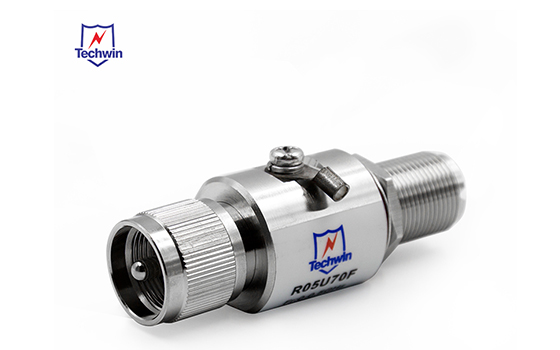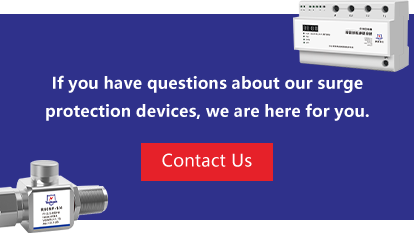Currently, the world is experiencing significant changes, including planning and establishing new mobile radio sites, as well as revitalizing and expanding existing network infrastructure. In the era of 5G, IoT, and autonomous driving, the increasing demand for enhanced transmission capacity and network availability continues to drive the expansion of existing structures.
These changes impact the accessibility of cellular base station installations and systems. However, because mobile phone masts are exposed, they are susceptible to repeated direct lightning strikes, which can disrupt the entire system. Additionally, damage is often caused by surges, such as those from lightning strikes near mobile radio sites. Even individuals near these facilities during thunderstorms face safety risks.

For mobile operators, lightning strikes are an unwelcome but inevitable problem. These towers can be quite tall, ranging from 50 feet to 200 feet, with some reaching up to 2000 feet. Because they often stand alone, they are highly vulnerable to lightning strikes.
Direct lightning strikes can release voltages as high as 100,000 volts (sometimes even higher), which can severely damage unprotected equipment. Despite extensive research, accurately predicting when and where lightning will occur remains uncertain. Furthermore, secondary effects of lightning may result in equally harmful voltage surges. These surges can occur even if the lightning is not very close. Hence, lightning-induced surges frequently happen.
After a lightning event, grounding lines may produce voltage spikes. Induction loops generated by the interaction of power lines and data lines can pick up nearby voltage surges. Exposed overhead power cables can transmit surges over long distances to various distribution systems. Even the wires from tower antennas to base stations can carry surges.
Due to the critical importance of sensitive electronic equipment and complex computers for infrastructure, induction surges can damage circuits in connected devices if not adequately protected. This is why installing surge protective devices is crucial to avoid the cost of repairs, replacements, and downtime. To keep cellular tower systems connected, the antenna surge protective device needs to meet strict standards for managing surges, especially regarding the highest test currents and maximum surge discharge during lightning. These devices must consistently redirect or absorb various surges caused by lightning without failure. Such reliability reduces the need for maintenance, repairs, and extra parts.
Cellular base stations are critical to communication infrastructure and must be shielded from surges caused by lightning. One of the primary concerns for telecom operators is towers going offline due to lightning strikes, which often target the tallest structures in an area. These towers are crucial because they must provide robust connectivity to ground users.
When lightning strikes the top of a cellular tower, it damages equipment located there, such as receivers, antennas, and remote radio heads. Additionally, this equipment connects to the gear at the bottom of the tower responsible for sending signals through the network. Surges from lightning also damage the base station's equipment. The surge travels along the cables connecting the top and bottom of the tower, affecting precision equipment on both ends.
To prevent further damage, industrial antenna surge protective devices can be strategically placed to divert surges away from sensitive equipment, thereby limiting the impact area. By integrating antenna surge protective devices into wireless cellular base stations, operators can reduce downtime and repair costs during lightning events. This enhances customer network functionality and improves company profitability.
Installing surge protective devices within cellular base stations is a beneficial move for all parties involved. To ensure optimal protection for your cellular base stations and other sensitive equipment, Techwin offers a range of high-performance antenna surge protective devices. To learn more about Techwin's products and services, please visit our website or contact our sales team.
 Selection Principle of Surge Protector in Distribution BoxJune 20, 2022(1) The voltage protection level Up of SPD should always be less than the impulse withstand voltage Uc of the protected equipment, and greater than the maximum operating voltage Us of the power grid o...view
Selection Principle of Surge Protector in Distribution BoxJune 20, 2022(1) The voltage protection level Up of SPD should always be less than the impulse withstand voltage Uc of the protected equipment, and greater than the maximum operating voltage Us of the power grid o...view The Difference Between Surge Protector and Air SwitchJuly 8, 2022Air switches and surge protectors are usually installed in the distribution box of a building, so what is the difference between them? Tiandun Thunderbolt will do a detailed analysis for you.Ⅰ. Surge...view
The Difference Between Surge Protector and Air SwitchJuly 8, 2022Air switches and surge protectors are usually installed in the distribution box of a building, so what is the difference between them? Tiandun Thunderbolt will do a detailed analysis for you.Ⅰ. Surge...view How do SPDs work?March 3, 2023SPD stands for Surge Protective Device, which is a device that is designed to protect electrical and electronic equipment from voltage surges and transients. Here is a brief explanation of how SPDs wo...view
How do SPDs work?March 3, 2023SPD stands for Surge Protective Device, which is a device that is designed to protect electrical and electronic equipment from voltage surges and transients. Here is a brief explanation of how SPDs wo...view Guide to the Function and Selection of Surge Protection Device for LightningMarch 18, 2025As lightning hazards pose increasing threats to buildings and electronic devices, Surge Protection Device for Lightning has become particularly important in modern buildings and power systems. This ar...view
Guide to the Function and Selection of Surge Protection Device for LightningMarch 18, 2025As lightning hazards pose increasing threats to buildings and electronic devices, Surge Protection Device for Lightning has become particularly important in modern buildings and power systems. This ar...view Gigabit Ethernet Surge Protector: Safeguarding the Stable Operation of Smart Cities and Digital Monitoring SystemsApril 23, 2025As society continues to develop, smart cities and intelligent buildings are emerging everywhere like mushrooms after rain. We can see various digital network cameras standing on street corners, quietl...view
Gigabit Ethernet Surge Protector: Safeguarding the Stable Operation of Smart Cities and Digital Monitoring SystemsApril 23, 2025As society continues to develop, smart cities and intelligent buildings are emerging everywhere like mushrooms after rain. We can see various digital network cameras standing on street corners, quietl...view What is the Residual Voltage of the Surge Protector?March 23, 2022What is the residual voltage of the surge protector? When the SPD device is selected and adapted, its various parameters will be comprehensively considered, and a comprehensive selection will be made....view
What is the Residual Voltage of the Surge Protector?March 23, 2022What is the residual voltage of the surge protector? When the SPD device is selected and adapted, its various parameters will be comprehensively considered, and a comprehensive selection will be made....view